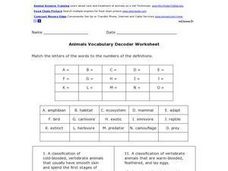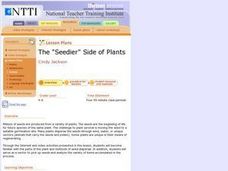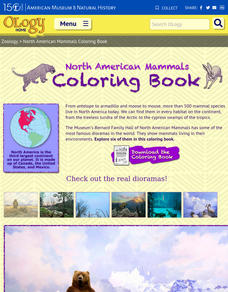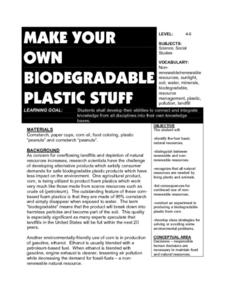Curated OER
Animals Vocabulary Decoder Worksheet
Add some decoding to your scholar's review of basic life science terms in this decorder worksheet, where learners match 15 words to their definitions. Words such as mammal and amphibian must be matched to their written definition. The...
Curated OER
Pond Animals
In this science worksheet, learners read about a pond and draw their own plants and animals to the picture. Learners also name six water plants and ten small animals that live in and around the pond.
NASA
Biology Training Module
Are you a koalafied biologist? The lesson begins with research about human survival and our ecosystem. Then, an online training module simulates the effects of changes to the plants and animals in an ecosystem. Finally, scholars research...
Curated OER
Seed Dispersal By Animals
In this seed dispersal by animals instructional activity, students read for information and complete comprehension activities. In this short answer instructional activity, students answer nine questions.
Curated OER
Meet the Plants
Students examine the difference between living and non-living things. In this living versus non-living lesson, students complete a KWL worksheet and a Living and Non-Living Chart. They examine a variety of plants and non-plants before...
Curated OER
The "Seedier" Side of Plants
Students demonstrate seed dispersal vectors through role-play, analyze seed types, identify plant parts, list seven conditions plants need in order to grow, and describe how seeds travel.
Curated OER
PLANT LIFE CYCLES
Student learns about the life cycle of plants by watching a time-lapse video. This activity provides young scholars with further evidence that all living things grow and change as they progress through their life cycle. Student conducts...
Curated OER
Growth and Changes in Plants
Students investigate the growth and changes in plants. They view a video and discuss the changes in plants. They work in small groups to demonstrate vocabulary words to the class. They visit a green house and take pictures of plants to...
Curated OER
Growing Plants
Students explore plants and recognize that they are living things that require light and water to grow. In this online plant biology lesson, students identify, name and match the parts of plants. Extension activities and suggested...
American Museum of Natural History
North American Mammals Coloring Book
Seven pages offer scholars the opportunity to learn about North American mammals and boost their coloring skills. Animals include brown bears, beavers, jackrabbits, wolves, jaguar, and Dall sheep
Curated OER
Animals
First graders study the basic needs of animals and compare them to human needs. They make bird feeders using milk carton and pine cones. They review the basic needs of food, water, air, and shelter and discuss what happens when animals...
Curated OER
Ecosystems - Plants and Animals Together
Students study the biotic and abiotic factors of an environment. In this exploratory lesson students examine the different trophic levels and how organisms are connected.
Curated OER
Smarty Plants
Students examine plants and pollinators. In this plant biology lesson plan, students read The Power of Pollinators and identify the parts of the plant and the pollinators. Students design their own imaginary plants.
Curated OER
Get to Know: Plants
Students complete a research activity in a schoolyard or park to learn about plants. In this plant lesson plan, students learn the name of the one of more plants. Students describe or draw the plant, pointing our features that...
Curated OER
Polar Bear Needs a Home!
Third graders are introduced to the topic of habitat . They create a zoo exhibit fo a polar bear that is being donated to the Albuquerque Zoo. The zoo is not big enough for a brand new cage, so the students choose which of three...
Scholastic
Study Jams! The Nitrogen Cycle
Expose your class to the steps of the nitrogen cycle with this short clip. Colorful computer imagery and animation explain how nitrogen travels from the atmosphere as a gas into plants and soil, where bacteria convert it into nitrates....
American Museum of Natural History
What's This? Feeding
Some species have pretty creative methods for catching food. Young scientists learn about some interesting ways organisms get the nutrients they need by navigating an online interactive lesson that would be suitable for a remote learning...
K12 Reader
Fungi Are Alive
They are alive even though they are neither plants or animals! Yes, fungi are the subject of this two-part comprehension worksheet. Kids read the article and then use information found there to respond to comprehension questions.
Curated OER
Make Your Own Biodegradable Plastic Stuff
Students identify the four basic natural resources. They distinguish bettween renewable and non-renewable resources. Pupils recognize that all natural resources are needed by living plants and animals. Students list consequences for...
Curated OER
Keys and Classifying
Students classify plants and animals. In this organisms instructional activity, students define classification and sort various objects according to its attributes. Students then research wildlife of Utah and group the organisms into...
Curated OER
Variation
Students recognize similarities and differences in plants. In this plants and animals lesson, students begin to classify living things by observable characteristics. Students watch clips from the Internet and play online games. Students...
Curated OER
To Eat or Not to Eat?
Young scholars identify various parts of plants and determine which parts people eat. They conduct a celery stalk experiment in which they determine the value and use of the stem, and how it helps the plant to meet its needs. Students...
Curated OER
"Five Little Seeds"
Fourth graders complete various activities related to the plant life cycle. They read the book "The Tiny Seed," read and discuss the poem "Five Little Seeds," complete a "Plantenstein Mystery" and other online activities, write and...
Curated OER
Living it up with plants
Have kids in grades K-2 discuss how they know a tree is alive. The worksheet provides simplistic background information and an observation check list. They check off the ways that they can tell an oak tree is a living thing. Note: The...
























